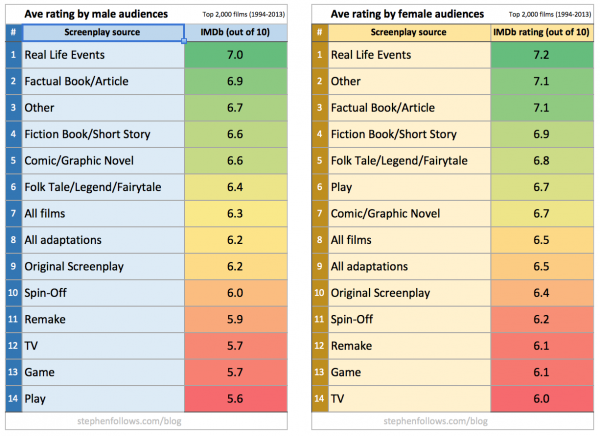 Today’s article is a mash-up of two topics I’ve previously covered. Last month, I published research into the source of Hollywood screenplays (i.e. script adaptations) and last week I investigated how audiences and critics rate films. So, it seemed only natural to put these two topics together and look at how critics and audiences rate films that come from different screenplay sources. I looked at the top 100 grossing films of each of the past 20 years (giving me 2,000 films to study) to calculate the average ratings given by IMDb users and the Metascore (i.e. film critics). In summary…
Today’s article is a mash-up of two topics I’ve previously covered. Last month, I published research into the source of Hollywood screenplays (i.e. script adaptations) and last week I investigated how audiences and critics rate films. So, it seemed only natural to put these two topics together and look at how critics and audiences rate films that come from different screenplay sources. I looked at the top 100 grossing films of each of the past 20 years (giving me 2,000 films to study) to calculate the average ratings given by IMDb users and the Metascore (i.e. film critics). In summary…
- Screenplays based on true life events make the highest rated films
- Films with original screenplays receive lower than average ratings
- Critics and audiences both feel that video games make the worst films
- Men and women’s opinions differ most about films based on plays
- Surprisingly, audiences of different age groups do not have different tastes when it comes to screenplay sources
- On average, sequels are worse than original films
With script adaptations truth is better than fiction
Screenplays based on real life events, factual books and factual articles receive the highest ratings by both critics and audiences. Video game script adaptations receive the lowest scores. 
Gender
Male and female audience members tend to rate different screenplay sources the same. With one notable exception – Plays. Men rated plays the lowest source of film screenplays (5.6) whereas women placed them in the top half (6.7).

Age
Across age brackets, there is no real difference between how users rated screenplay sources.  This is interesting as it is often assumed that younger audiences enjoy different types of films to older audiences. This is clearly the case when we look at the box office figures: for example, younger audiences pay to go and see films based on video games over true life events. However, it seems that regardless of what they pay to see, when asked to rate films based on different sources, all audience age groups broadly agree.
This is interesting as it is often assumed that younger audiences enjoy different types of films to older audiences. This is clearly the case when we look at the box office figures: for example, younger audiences pay to go and see films based on video games over true life events. However, it seems that regardless of what they pay to see, when asked to rate films based on different sources, all audience age groups broadly agree.
So, this poses the question: if everyone has the same understanding of what makes a high quality film, why do different age groups pay to see different films? I suggest: each age group places a different importance on quality when deciding which film to watch. Put simply – we all know which movies are good, but younger audiences don’t care as much. It could be argued that older audiences are more influenced by reviews and word of mouth, whereas a younger audience is swayed by marketing to a greater degree.
Shock news: Sequels are weaker than originals
Sequels receive lower ratings than non-sequels. 
Methodology for script adaptations
The data for today’s research came from IMDb, Opus, Rotten Tomatoes and Metacritic. I focused on the top 100 films at the domestic box office for each of the 20 years between 1994 and 2013.
Epilogue
As always, if you have a question about film you want me to investigate then drop me a line.





Comments
The “other” category rates pretty high. What might that include?
Good question. The sources in Other are based on a short film, theme park ride, religious text, musical, opera or toy. This accounted for just 26 films in total, or 1.3% of my sample. I felt that when you deal with such small numbers of movies then the stats are less meaningful so I grouped them in Other.
Stephen. I have been in the industry for several years now and just recently came across your blog. Just wanted to say you’re doing a fantastic job! – Sam Blan